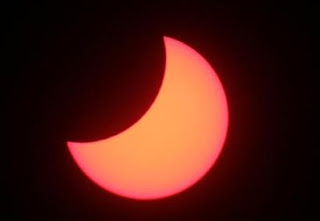Total Solar Eclipse of August 01, 2008
On Friday, August 01, 2008, a total eclipse of the Sun is visible from within a narrow corridor that traverses half the Earth. The path of the Moon's umbral shadow begins in Canada and extends across northern Greenland, the Arctic, central Russia, Mongolia, and China. A partial eclipse is seen within the much broader path of the Moon's penumbral shadow, which includes northeastern North America, most of Europe and Asia.
Other photos and images during the Total Solar Eclipse.
 Graphic showing the path of the solar eclipse. Thousands of people gathered across Arctic regions, Siberia and China to see a total eclipse of the sun, despite Chinese warnings that it could augur bad luck.
Graphic showing the path of the solar eclipse. Thousands of people gathered across Arctic regions, Siberia and China to see a total eclipse of the sun, despite Chinese warnings that it could augur bad luck.
 In this photo released by China's Xinhua News Agency, the total solar eclipse is observed at 7:21 pm (1121 GMT) on Friday, Aug. 1, 2008 in north of Xi'an, capital of northwest China's Shaanxi Province. The total solar eclipse, the first that can be viewed in China in the new century, occured on Friday.
In this photo released by China's Xinhua News Agency, the total solar eclipse is observed at 7:21 pm (1121 GMT) on Friday, Aug. 1, 2008 in north of Xi'an, capital of northwest China's Shaanxi Province. The total solar eclipse, the first that can be viewed in China in the new century, occured on Friday.
 A solar eclipse, which the Chinese word for is 'Rishi' meaning 'eaten sun', can be seen above the Jiayuguan Fort on the Great Wall of China in the town of Jiayuguan, Gansu Province August 1, 2008.
A solar eclipse, which the Chinese word for is 'Rishi' meaning 'eaten sun', can be seen above the Jiayuguan Fort on the Great Wall of China in the town of Jiayuguan, Gansu Province August 1, 2008.
 A partial solar eclipse is seen in Riga, August 1, 2008. Picture taken with special filter.
A partial solar eclipse is seen in Riga, August 1, 2008. Picture taken with special filter.
 The total solar eclipse is observed above the Siberian city of Novosibirsk on Friday, Aug. 1, 2008. An enormous swathe of western Siberian was submerged in darkness Friday afternoon as the moon completely blocked out the sun, enrapturing huge crowds of Russians and foreign tourists.
The total solar eclipse is observed above the Siberian city of Novosibirsk on Friday, Aug. 1, 2008. An enormous swathe of western Siberian was submerged in darkness Friday afternoon as the moon completely blocked out the sun, enrapturing huge crowds of Russians and foreign tourists.
 A photographer using a special filter takes photographs of a partial solar eclipse in Riga, August 1, 2008
A photographer using a special filter takes photographs of a partial solar eclipse in Riga, August 1, 2008
 People watch a full solar eclipse in a yacht-club on the bank of River Ob in the Siberian city of Novosibirsk, August 1, 2008. For the thousands who flocked from around the world to Novosibirsk, awe mixed with excitement as day turned into night. They gazed in wonder as an eerie silence descended on the Siberian city and gusts of unusually strong wind tore through the crowd. Birds stopped chirping and the temperature suddenly dropped.
People watch a full solar eclipse in a yacht-club on the bank of River Ob in the Siberian city of Novosibirsk, August 1, 2008. For the thousands who flocked from around the world to Novosibirsk, awe mixed with excitement as day turned into night. They gazed in wonder as an eerie silence descended on the Siberian city and gusts of unusually strong wind tore through the crowd. Birds stopped chirping and the temperature suddenly dropped.
 A solar eclipse, which the Chinese word for is 'Rishi', meaning 'eaten sun', can be seen above Jiayuguan Fort on the Great Wall of China in the town of Jiayuguan, Gansu Province August 1, 2008.
A solar eclipse, which the Chinese word for is 'Rishi', meaning 'eaten sun', can be seen above Jiayuguan Fort on the Great Wall of China in the town of Jiayuguan, Gansu Province August 1, 2008.
images source: eclipse.gsfc.nasa.gov & news.yahoo.com
 Graphic showing the path of the solar eclipse. Thousands of people gathered across Arctic regions, Siberia and China to see a total eclipse of the sun, despite Chinese warnings that it could augur bad luck.
Graphic showing the path of the solar eclipse. Thousands of people gathered across Arctic regions, Siberia and China to see a total eclipse of the sun, despite Chinese warnings that it could augur bad luck. In this photo released by China's Xinhua News Agency, the total solar eclipse is observed at 7:21 pm (1121 GMT) on Friday, Aug. 1, 2008 in north of Xi'an, capital of northwest China's Shaanxi Province. The total solar eclipse, the first that can be viewed in China in the new century, occured on Friday.
In this photo released by China's Xinhua News Agency, the total solar eclipse is observed at 7:21 pm (1121 GMT) on Friday, Aug. 1, 2008 in north of Xi'an, capital of northwest China's Shaanxi Province. The total solar eclipse, the first that can be viewed in China in the new century, occured on Friday. A solar eclipse, which the Chinese word for is 'Rishi' meaning 'eaten sun', can be seen above the Jiayuguan Fort on the Great Wall of China in the town of Jiayuguan, Gansu Province August 1, 2008.
A solar eclipse, which the Chinese word for is 'Rishi' meaning 'eaten sun', can be seen above the Jiayuguan Fort on the Great Wall of China in the town of Jiayuguan, Gansu Province August 1, 2008. A partial solar eclipse is seen in Riga, August 1, 2008. Picture taken with special filter.
A partial solar eclipse is seen in Riga, August 1, 2008. Picture taken with special filter. The total solar eclipse is observed above the Siberian city of Novosibirsk on Friday, Aug. 1, 2008. An enormous swathe of western Siberian was submerged in darkness Friday afternoon as the moon completely blocked out the sun, enrapturing huge crowds of Russians and foreign tourists.
The total solar eclipse is observed above the Siberian city of Novosibirsk on Friday, Aug. 1, 2008. An enormous swathe of western Siberian was submerged in darkness Friday afternoon as the moon completely blocked out the sun, enrapturing huge crowds of Russians and foreign tourists.  A photographer using a special filter takes photographs of a partial solar eclipse in Riga, August 1, 2008
A photographer using a special filter takes photographs of a partial solar eclipse in Riga, August 1, 2008 People watch a full solar eclipse in a yacht-club on the bank of River Ob in the Siberian city of Novosibirsk, August 1, 2008. For the thousands who flocked from around the world to Novosibirsk, awe mixed with excitement as day turned into night. They gazed in wonder as an eerie silence descended on the Siberian city and gusts of unusually strong wind tore through the crowd. Birds stopped chirping and the temperature suddenly dropped.
People watch a full solar eclipse in a yacht-club on the bank of River Ob in the Siberian city of Novosibirsk, August 1, 2008. For the thousands who flocked from around the world to Novosibirsk, awe mixed with excitement as day turned into night. They gazed in wonder as an eerie silence descended on the Siberian city and gusts of unusually strong wind tore through the crowd. Birds stopped chirping and the temperature suddenly dropped.  A solar eclipse, which the Chinese word for is 'Rishi', meaning 'eaten sun', can be seen above Jiayuguan Fort on the Great Wall of China in the town of Jiayuguan, Gansu Province August 1, 2008.
A solar eclipse, which the Chinese word for is 'Rishi', meaning 'eaten sun', can be seen above Jiayuguan Fort on the Great Wall of China in the town of Jiayuguan, Gansu Province August 1, 2008. images source: eclipse.gsfc.nasa.gov & news.yahoo.com























0 comments:
Post a Comment